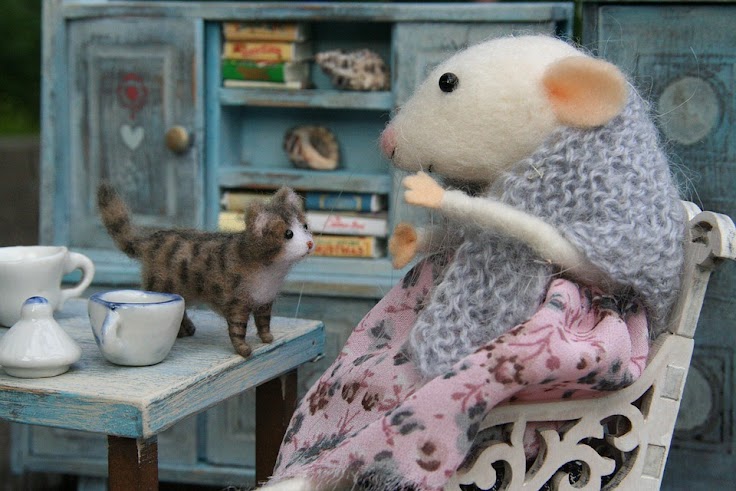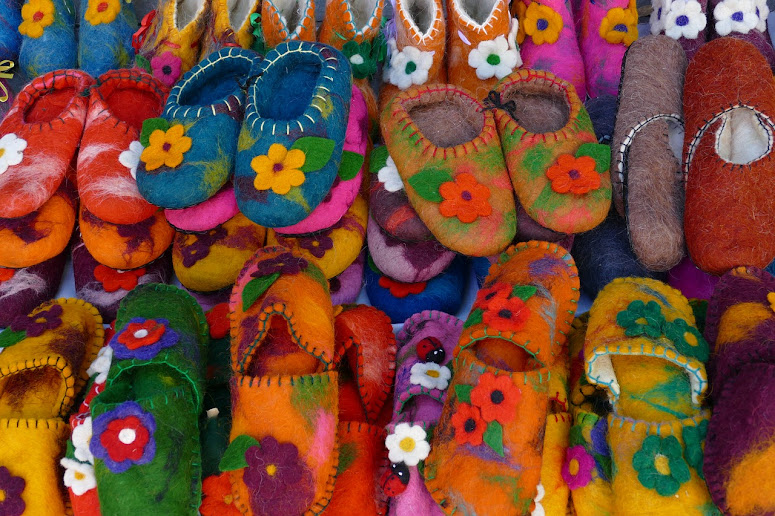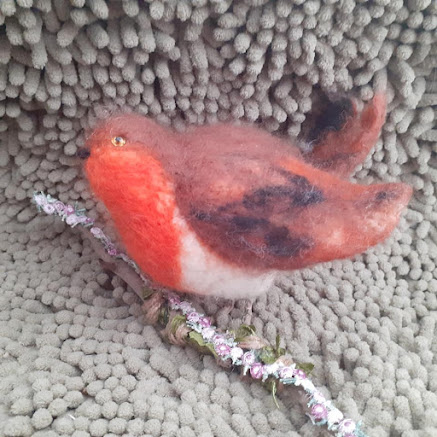 I had never tried or even heard of needle felting until a few months ago, when my cousin posted a picture on her Facebook page of a rather straggly-looking wool cat she had made (not the one in the pic). I jokingly laughed and said it looked like something out of Stephen King's Pet Cemetery novel. I knew nothing about the needle felting art and craft, let alone the skill required. Fortunately, my cousin has a great sense of humour and was amused by my remark. Scroll forward a few months, I'm home and in isolation for three weeks with covid (despite being vaccinated ), so I decided to try my hand at needle felting. In that time, I've become a needle felting addict, as evidenced by some of the photos below (not all crafts pictured are my own, where they are not mine I have linked the images back to their source). I've since ordered a lot of new materials because I love needle felting so much. I definitely intend to keep doing it and will most likely be needle felting in front of the TV during my downtime nearly every other night, if not every night.
I had never tried or even heard of needle felting until a few months ago, when my cousin posted a picture on her Facebook page of a rather straggly-looking wool cat she had made (not the one in the pic). I jokingly laughed and said it looked like something out of Stephen King's Pet Cemetery novel. I knew nothing about the needle felting art and craft, let alone the skill required. Fortunately, my cousin has a great sense of humour and was amused by my remark. Scroll forward a few months, I'm home and in isolation for three weeks with covid (despite being vaccinated ), so I decided to try my hand at needle felting. In that time, I've become a needle felting addict, as evidenced by some of the photos below (not all crafts pictured are my own, where they are not mine I have linked the images back to their source). I've since ordered a lot of new materials because I love needle felting so much. I definitely intend to keep doing it and will most likely be needle felting in front of the TV during my downtime nearly every other night, if not every night. What is Needle felting?
Needle felting is the process of forcing wool fibers together with the help of the barbs on the needles in order for them to be felt. When you poke the fibers with your needles, the fibers will become denser and more firmly felted as a result of the poking.
Needle felting is an unusual craft because you are literally sculpting something by stabbing wool with a needle. It appears simple, and in some ways it is (how difficult is it to stab something?) but not so much because your 'stabs' must be strictly guided and you must visualize something in 3D that is essentially a fluffy blob to begin with.
Fortunately, there are numerous excellent tutorials available online to assist you in getting started and honing your skills. I'm a member of a couple of needlefelting Facebook groups that are fantastic for inspiration, tips, peer review, and assisting you in improving your needle-felt craft. It's a wonderful community, and there are some incredibly talented needle felters there.
Do you want to try Needle Felting yourself?
It's possible that you've seen some adorable needle felted figures and thought to yourself, "I could do that!" Yes, it is possible!! Needle felting is a lot of fun, and it is simple for even a complete beginner to achieve excellent results!
Needle Felting Tools for beginners
First and foremost, there are the felting needles. They are a one-of-a-kind tool that is available in a variety of sizes and with varying numbers of barbs. If you're a beginner, the star needle (number 38) would be the most useful of the available needles. Star needles have four edges, as opposed to the triangular tips of the majority of them, which have barbs on three of their edges. The more edges and barbs you have, the faster you will be able to complete your needle felted sculpture.
Although the #38 star is not the best needle for all types of felting tasks, it is by far the most useful and is all you really need to get started with the craft. It is also the most affordable.
The second thing you need is felting fiber. There are so many different types of fiber available for the purpose of needle felting that it would take an inordinate amount of time to cover them all here. In order to get started, wool is the most fundamental and widely used fiber for needle felting. Even in the case of wool, there is a great deal of choice. Sheep wool has distinct characteristics that are specific to each breed of sheep.Merino and Corriedale wool fibers are the most commonly used wool fibers in the world. These are named after the sheep breeds that they represent. Merino is a fiber that is extremely fine and soft to the touch, and it is the fiber of choice. When needle felted, it produces a surface that is extremely smooth.
Merino takes more effort to needle felt than Corriedale, which is a good thing. Corriedale wool is not as fine as Merino wool, but it felts beautifully nonetheless. Corriedale is an excellent choice for those who are just starting out. Many different colors are available in both Merino and Corriedale wool.The third component is a work surface. In order to work effectively, you need a work surface that allows you to thrust your needles through the fiber without hitting the table or even worse, your hand.
The majority of people who are just getting started with needle felting use a thick, dense foam pad as their first work surface. Such pads are readily available at fabric and craft stores, and they will undoubtedly perform the required function. In order to get the most out of your needle felting and to make it more enjoyable, it is recommended that you purchase a Clover Brush Mat.
Despite the fact that you rarely cut the fiber that you needle felt, scissors can be useful when finishing a piece because they can trim those flyaway fibers that just didn't seem to feel down when you needle felted them.The use of needle and thread can be used to define a mouth, secure beads for eyes, and create divisions in paws to give the appearance of toes.
Chenille sticks, pipe cleaners, craftwire can be used to create legs that are strong enough to support the weight of the figure when starting a project from the beginning. After a while, if you want to keep doing this art and enjoy working with an armature, you should consider switching from chenille sticks to stainless steel or aluminum wire.
Long straight pins are useful for pinning sections of your felted creature together so that the pieces can be firmly felted together after they have been pinned together.
This set of needle felting tools and materials allows you to create almost anything!! Although needle felting is not particularly difficult to learn, there is a lot to be learned about controlling the density of your fiber and using the needles to achieve the best results when you first start out. There are a plethora of crafting classes available right now for beginners, intermediates, and advanced students, among other levels of expertise. You will gain knowledge and skills that you will be able to apply to any project you choose to undertake.
Let's get started
To felt, take your wool felting needle and jab it up and down repeatedly through the roving and your knitted item until it reaches the foam beneath it. Now, please, please keep an eye on your fingers because, even though it doesn't appear to be very sharp, if you poke yourself, it will hurt extremely badly, and I am confident that you will do so only once and for a very short period of time.
First and foremost, you'll need to tack down the layer of roving until it's firmly secured in position. For smaller details, you can twist the piece of yarn, roll it up if you want, and lay it over the top of your knitting, poking the needle down into and out of the knitting until it is securely fastened in place. To make sure that your needle felted design is securely fastened to your knitting, tug on it a little bit. You'll also want to check the entire area to ensure that everything is securely fastened.
It is also possible to needle felt on top of other felting. As an example, if you've made felted bags, felted purses, or felted slippers, you can take a small piece of the yarn, or contrasting yarn, or some roving and create a small swirly design on them with your fingers. You can make a flower out of it. You can make a snowflake or anything else you want. You can even include a person's name. Consider the following scenario: you want to make them a pair of slippers for the house. A piece of wool yarn can be used to needle felt their name onto a piece of felting needle. Enjoy yourself and use your imagination to the fullest extent possible.
Other Types of Felting
Felting, Nuno
Nuno felting is a Japanese technique that combines loose animal fibers with sheer fabrics such as silk gauze using hot water, soap, and a rolling process. When mixed, the silk retains its shape and stability while incorporating the added softness and rich color of the dyed fibers. You can find numerous examples of this process by searching the term felted silk scarves on the internet.
Felting, Flat
Flat felting is similar to Nuno felting in that it uses hot water and soap, but instead of binding the wool fibers to fabric, they are simply bound to each other. Different fiber colors can be combined to create an eye-catching marbling effect. Only a couple of layers of fiber are used to make a thin flannel that is pliable and can be stitched together. More layers are piled on for a thicker and more firm end product.
Felting with Knits
Everyone knows that washing and drying a wool sweater causes it to shrink and become unwearable, but that is exactly what a number of crafters are attempting. By purposefully shrinking and felting old wool, angora, and merino sweaters in the wash, they are recycled for new handicraft projects. Other crafters were astute enough to knit extra long and loose strips, then felt the finished product in the washing machine. These newly felted fabrics can then be sewn into bags, scarves, or other felt products in either case.
Felting in 3 Dimensions
3D felt sculpting, like wet clay sculpting, entails gluing together various shapes and sizes of fibers and needle felting them into place. Using the same technique, different color accents can be added. Soft sculptures, such as animal and doll figures, can be made by roughly shaping clumps of fiber and then detailing them with felting needles.
The History Of Felting
Felt is the world's oldest fabric, predating both weaving and knitting. According to Wikipedia, felt is a nonwoven fabric formed by matting, condensing, and pressing fibers.
According to research, felt making began with nomadic peoples in Central Asia and spread westward toward Hungary, then northward through Europe and into Scandinavia. The best fossil evidence suggests that wild sheep evolved between 10 and 20 million years ago in Central Asian mountains. These sheep possessed hairy outer coats and woolly undercoats that molted annually in the spring. Their coats ranged in color from black to brown to gray to reddish, depending on the color that best concealed them in a given environment. Sheep were domesticated approximately 12,000 years ago, and herders quickly discovered the felting properties of wool. However, primitive people may have discovered earlier that wild sheep's wool could be felted, spun, and woven.
The earliest evidence of felt use dates from the Neolithic period in Turkey, approximately 8,000 years ago. Additionally, well-preserved examples of ancient felt have been discovered in China and Siberia. In northwest China, 3,000-year-old Caucasian mummies wearing felt hats and boots have been discovered. In the early twentieth century, archaeologists discovered graves of a nomadic people known as the Pazyryk in Siberia's Altai Mountains. The graves contained an abundance of felt articles with sophisticated animal motifs in a variety of colors, shapes, and sizes.
Historically, as societies became more industrialized and manufactured alternatives became available, the importance of felt making waned. Even in recent history, parts of Mongolia lost the craft as people moved away from the steppes and plains that sustained their nomadic lifestyle and into towns and cities. It is possible that felt clothing fell out of favor during the Middle Ages as woven cloth appeared to be more comfortable and fashionable. The felt hat, on the other hand, has never gone out of style in industrialized societies.
Beginning in the mid-1980s, feltmaking experienced a renaissance in North America, with an influx of new craftspeople and fiber artists discovering this ancient craft.
Shop by Gift Types












Social Plugin